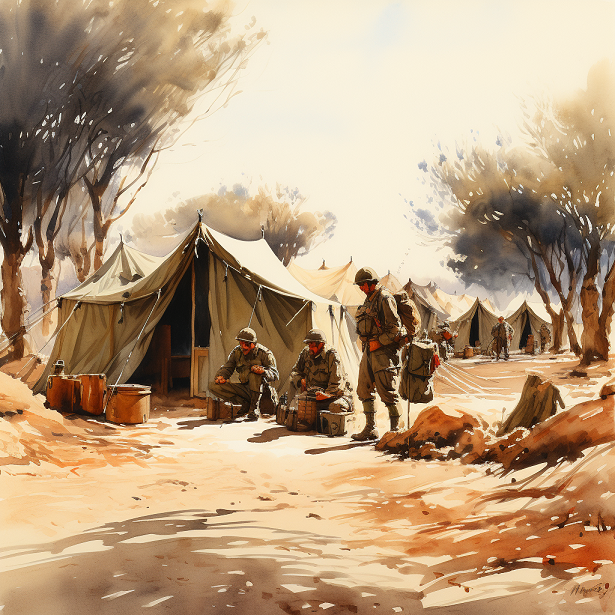T.E. Lawrence, a figure who looms large in the modern history of the middle east, was a British military officer whose life and exploits intersected with the labyrinthine paths of General Sir Archibald Murray, General Sir Edmund Allenby, and a cohort of British and French officers and political officials during the Arab Revolt of WWI. Born in 1888, Lawrence, a man of paradoxes, blended the attributes of an amateur soldier with an intellectual acumen that set him apart. As the Arab Revolt unfurled its complexities, Lawrence’s trajectory evolved from the periphery to the epicentre, weaving an enigmatic thread that connected the key players and orchestrated a symphony of war and diplomacy. Within this intricate dance, Lawrence’s influence would resonate, shaping the destinies of nations and etching his name into the tapestry of the Arab Revolt.
General Sir Archibald Murray
In the turbulent onset of the Arab Revolt in 1916, the helm of the Egyptian Expeditionary Force was firmly in the hands of General Sir Archibald Murray. Initially, Murray’s leadership bore the weight of both acclaim and censure. Accused of embodying an unimaginative approach, he navigated the delicate balance of steering the Arab Revolt through its formative years.
Murray’s significance lay in his pivotal role, orchestrating the logistical underpinnings of the revolt. Arms, money, and troops flowed under his stewardship, a lifeline binding the British military to the aspirations of the Arab rebels. Yet, Murray’s caution in committing additional forces stemmed not from indifference but from the harsh realities of war. Logistical challenges, coupled with a historical aversion to what he perceived as costly “sideshows,” restrained his enthusiasm for extensive military involvement.
It was in this intricate dance of leadership and constraint that T.E. Lawrence entered the stage, a figure whose influence would crescendo in the unfolding drama of the Arab Revolt. While Murray grappled with the complexities of wartime strategy, Lawrence’s presence, though not yet central, hinted at a force that would later alter the course of history.
General Sir Edmund Allenby: Reshaping the Destiny of the Arab Revolt
In the symphony of war, the baton passed from General Sir Archibald Murray to a stalwart hero of British arms, General Sir Edmund Allenby, in June 1917. Allenby’s appointment marked a critical juncture, a moment when the Egyptian Expeditionary Force languished in demoralisation, and the Arab Revolt teetered on the edge of uncertainty.
Allenby, a luminary of World War I, brought more than a decorated military past; he infused the beleaguered force with renewed vigour and strategic insight. Recognizing the latent potential of the Arab Revolt as a formidable weapon against the Ottoman Empire, Allenby orchestrated a renaissance. He meticulously reorganised the military apparatus, dispelling the shadows of demoralisation that had haunted the Egyptian Expeditionary Force.
With a keen eye on strategic advantages, Allenby not only provided tangible support in the form of armoured cars and air cover but also served as the catalyst for the revolt’s geographical expansion northwards. This audacious move bore fruit as the Arab army, now under the protective wings of Allenby’s strategic vision, achieved resounding success in the pivotal years of 1917 and 1918.
It was during this transformative period that T.E. Lawrence, initially a peripheral figure, found his role evolving in tandem with the shifting sands of war. The groundwork laid by Allenby provided an enticing canvas upon which Lawrence would paint his indelible mark.
Orchestrating Support for the Arab Cause
As the wheels of the Arab Revolt began to turn, a cadre of British officers, not least among them T.E. Lawrence took centre stage, each contributing a unique thread to the intricate tapestry of the Hashemite rebellion.
In the antecedent chapters of the revolt, before T.E. Lawrence’s presence commanded the spotlight, several officers embarked on a mission to fortify the Hashemite rebellion. Among them, Colonels Cyril Wilson and Pierce C. Joyce assumed roles pivotal in the logistical underpinnings and strategic support that would lay the groundwork for Lawrence’s later exploits.

Colonel Stewart Francis Newcombe, an architect of raids against the Hejaz Railway, wove a narrative of audacity and tactical brilliance. These early acts of sabotage were the overture to the crescendo that Lawrence would later conduct, manipulating the railway as both a physical and symbolic battleground.
A French Overture: Harmonising with the Arab Cause
Amidst the dynamic tableau of the Arab Revolt, the French played a role, contributing their own cadence to the symphony of war. Under the official banner of the ‘Military Mission to Egypt,’ the French endeavoured to bolster the Arab cause with a strategic acumen that echoed across the arid landscapes.
Colonel Edouard Brémond, a seasoned officer with a rich history in North African campaigns, assumed the reins of the French mission. His focus on the southern campaign, particularly around the sacred cities of Mecca and Medina, underscored the French commitment to supporting the Hashemite rebellion in its vital theatres of operation.
A distinctive advantage for the French lay in their ability to field Muslim officers from North African regiments, providing a cultural resonance that aligned with the aspirations of the Arab rebels. This cultural alignment was not merely symbolic but a strategic leverage that facilitated cooperation and understanding on the battlefield.
In this Francophone alliance, Capitaine Rosario Pisani emerged as a prominent figure. Operating within the Arab Northern Army, Pisani’s contributions rippled beyond the battlefield. His support for the Arab cause extended to the diplomatic arena, where he played a role in shaping the post-war landscape at the Paris Peace Conference of 1919.
Political Machinations in the Arab Revolt
Behind the theatre of battle, where generals commanded and soldiers fought, puppeteers of policy pulled the strings that directed the ebb and flow of the Arab Revolt. A cadre of political officials from both the British and French governments orchestrated a delicate ballet, their decisions casting shadows and highlights upon the stage of war.
Notable figures such as Sir Mark Sykes, Georges Picot, Sir Reginald Wingate, Sir Henry McMahon, and Ronald Storrs emerged as the architects of policy, their hands firmly shaping the destiny of the revolt. Their roles were not merely bureaucratic; they were curators of a strategic vision that transcended the immediacy of the battlefield.
Sir Mark Sykes and Georges Picot, their names etched into the annals of history by the Sykes-Picot Agreement, wielded pens as mighty as any sword. Their ink traced lines across maps, delineating spheres of influence and marking the contours of post-war territories. The repercussions of their geopolitical chess game would resonate far beyond the confines of the Arab Revolt.
On the canvas of political influence, Sir Reginald Wingate, Sir Henry McMahon, and Ronald Storrs added their brushstrokes. Wingate, as Governor of the Sudan, brought his regional acumen to the table, while McMahon’s intricate negotiations and Storrs’ local governance played integral roles in shaping the larger narrative.
As these political architects crafted policies, T.E. Lawrence, though not a puppeteer, found himself intricately woven into their designs. His actions, a testament to the synergy between the military and political spheres, added depth and complexity to the unfolding drama. The decisions made in the corridors of political power reverberated through the ranks, where soldiers fought not only for victory on the battlefield but also for the realisation of political visions crafted by these puppeteers of policy.

